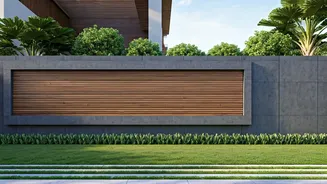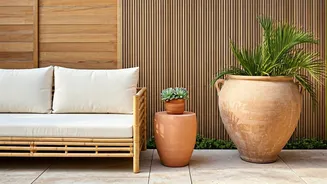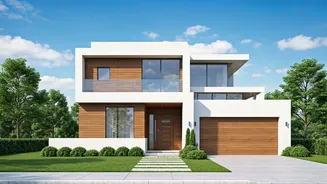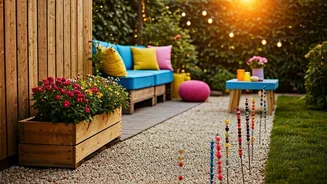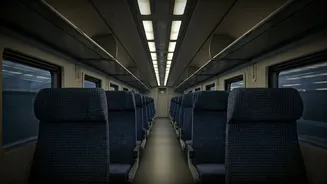Minimalist Design
The minimalist approach to home compound walls emphasizes simplicity and clean lines. These walls often feature smooth surfaces, neutral colors, and a lack
of ornamentation. The design's strength lies in its understated elegance, making it suitable for modern homes seeking a sophisticated, uncluttered look. The main materials used are concrete, rendering, or stucco, often complemented by subtle landscaping to enhance the overall aesthetic. Minimalist walls create a sense of spaciousness, making them ideal for smaller properties or those aiming for a serene environment. These walls focus on creating a visual statement through simplicity, ensuring they blend seamlessly with the home's architecture while still providing security and privacy. The color palette typically involves whites, grays, and blacks, allowing the home's features to stand out. Simple, well-placed lighting can highlight the wall's texture and form during the evenings.
Brick and Stone
Combining brick and stone offers a blend of textures, colors, and timeless appeal for a home compound wall. The earthy tones of brick paired with the natural variations of stone create a visually rich and inviting exterior. This design style suits homes with a classic or rustic aesthetic, adding warmth and character. Different brick types, such as red, brown, or even reclaimed brick, can be mixed with various stone choices like granite, limestone, or sandstone. The arrangement of the brick and stone can be customized, with patterns ranging from random placements to structured layouts. The durable nature of both materials ensures longevity and low maintenance, while the combination provides excellent protection and enhances curb appeal. This style complements gardens and outdoor spaces, creating an integrated look with the landscape. Adding climbing plants or accent lighting can further enhance the visual interest of this design.
Wooden Panel Decor
Wooden panels offer a warm, natural aesthetic for home compound walls, creating an inviting and stylish exterior. This design is versatile, with options ranging from vertical or horizontal planks to intricate lattice patterns. The wood can be stained, painted, or left natural, enhancing the home's architectural style. Using treated wood ensures durability and resistance to weathering, making it suitable for various climates. This design can incorporate built-in elements like planters or lighting, adding functionality and visual interest. Wooden panels bring a touch of nature, blending the home with its surroundings. The installation can be relatively straightforward, allowing for DIY projects or professional installations. Regular maintenance, such as sealing and occasional painting, ensures the wood's longevity and preserves its beauty, making it a sustainable choice for home exteriors.
Metal Grilles Design
Metal grilles and laser-cut panels bring a contemporary and artistic touch to home compound walls. These designs can range from simple geometric patterns to intricate, custom-made artworks, allowing for personalization. The use of materials like wrought iron, steel, or aluminum provides durability and a modern aesthetic. Laser-cut panels offer precision and the ability to create complex designs, adding a layer of sophistication. Metal grilles can act as both decorative elements and privacy screens, balancing openness with security. They are suited for modern and urban homes, adding a sleek and stylish element. The metal can be finished in various colors and textures, enhancing its visual impact and complementing the home's exterior. Integrating lighting behind the panels creates stunning effects during the evening, highlighting the patterns and adding ambiance.
Planter Wall Design
Incorporating planters into a home compound wall introduces greenery and enhances the aesthetic appeal. This design combines the structural elements of a wall with the natural beauty of plants, creating a refreshing and inviting environment. Planters can be integrated into the wall's structure or added as standalone features, allowing for various plant types and arrangements. The choice of plants can vary from flowering varieties to lush foliage, depending on the desired effect and climate. Planter walls provide a sustainable design option, improving air quality and promoting biodiversity. This design adds an organic touch, complementing modern and traditional architectural styles. The placement of planters can be customized, creating visual interest and defining boundaries. Adequate drainage and maintenance are essential to ensure the plants' health and the longevity of the wall. This design offers an elegant, low-maintenance solution.
Textured Plaster Finish
Textured plaster finishes add depth and visual interest to a home compound wall, providing a unique and stylish exterior. These finishes can range from rough, rustic textures to smooth, contemporary surfaces, offering versatility in design. Various techniques, such as troweling, spraying, or rolling, create different textures, allowing for customization. The choice of plaster colors and additives, like aggregates or pigments, further enhances the visual impact. Textured plaster is suitable for both traditional and modern homes, adding a sense of character and sophistication. It can be applied to various materials, including concrete, brick, and block, providing a cohesive and integrated look. The texture can also help to disguise imperfections and add visual interest, and it provides a durable, weather-resistant finish. Regular maintenance and occasional cleaning are essential to preserve the wall's aesthetic appeal.
Glass and Concrete
The combination of glass and concrete creates a striking and modern home compound wall, offering a blend of transparency and strength. Concrete provides a solid base and structural support, while glass panels add openness and visual appeal. The design can incorporate various glass types, from clear to frosted, allowing for different levels of privacy. The contrast between the smooth, industrial aesthetic of concrete and the reflective qualities of glass offers a unique aesthetic. This design is suited for modern homes aiming for a contemporary and sophisticated look. The glass can be incorporated as panels, inserts, or even as entire sections of the wall, creating visual connections with the surroundings. This design can also include built-in lighting to highlight the features during the evenings, adding to the visual appeal. The combination needs careful planning to ensure the structural integrity and aesthetic balance, but it provides a very elegant design.
Sculptural Walls
Sculptural walls transform a home compound wall into an art piece, creating a focal point for the exterior. These designs involve creating three-dimensional forms and patterns, offering a unique and artistic look. Sculptural elements can be achieved through various methods, including carving, molding, or assembling materials like concrete, stone, or metal. The design can range from abstract shapes to more representational forms, allowing for creative expression. Sculptural walls add a touch of individuality and sophistication to a home, setting it apart from others. They can be integrated with lighting and landscaping, highlighting the design's features and adding depth. This design offers a unique way to express creativity and personal style, creating a lasting impression. Sculptural walls require careful planning and execution to ensure the structural integrity and aesthetic balance, but the result is a beautiful and unique addition.
Horizontal Slat Design
Horizontal slat designs offer a sleek and modern look, providing privacy and ventilation for home compound walls. These walls feature horizontal wooden or metal slats, creating a streamlined and contemporary appearance. The design allows for varied spacing between the slats, controlling the level of privacy and light filtration. Wood slats bring warmth and natural texture, while metal slats offer a more industrial and durable alternative. Horizontal slats are suitable for modern homes, adding a clean and uncluttered aesthetic. This design enhances curb appeal and complements various architectural styles. The material chosen can be painted, stained, or left natural, allowing for customization. Installation is manageable and can be done professionally or as a DIY project, offering flexibility. Careful consideration of the spacing between slats and the overall design creates a balance between privacy and aesthetics.
Perforated/Jali Design
Perforated or Jali designs incorporate intricate patterns and openings, offering ventilation, privacy, and aesthetic appeal for home compound walls. These designs often feature laser-cut metal, concrete blocks, or traditional Jali screens. The patterns can be geometric, floral, or custom-designed, adding visual interest. Jali designs allow for natural light and air circulation, creating a comfortable environment. These designs are ideal for hot climates, providing shade and reducing heat buildup. They are versatile, suitable for traditional and modern homes, adding cultural richness and design. The materials used, like concrete or metal, can be durable and low-maintenance. This design can also incorporate lighting, accentuating the patterns and creating beautiful shadows. Regular cleaning and maintenance help to preserve the design and functionality.
Painted Murals
Painted murals on home compound walls introduce art and creativity, transforming the exterior into a vibrant canvas. Murals can range from abstract designs to detailed artwork, offering unique personalization. The paint used should be weather-resistant and suitable for outdoor use. This design allows homeowners to showcase their artistic interests or express a narrative. The mural can complement the home's architecture, adding visual interest and character. A well-executed mural can become a focal point, drawing attention and enhancing curb appeal. The artwork can be commissioned from a local artist or created as a DIY project. The design offers a unique way to personalize a home's exterior, adding color and flair. Regular maintenance, including cleaning and occasional touch-ups, helps preserve the mural's beauty and longevity.
Lighting Integration
Integrating lighting into home compound walls enhances both aesthetics and security, transforming the exterior during the evenings. The lighting can be embedded within the wall's structure, added as surface-mounted fixtures, or incorporated into landscape features. Options include spotlights, LED strips, or ambient lighting, allowing for customized effects. Lighting can highlight the wall's texture, design, and surrounding landscaping. Strategically placed lights increase security, deterring intruders and providing safety. The lighting scheme can be automated, with timers or sensors, for convenience and energy efficiency. Lighting integration is a versatile design element, complementing any architectural style. The choice of lighting fixtures and their placement can significantly impact the overall look. Professional installation ensures proper wiring and safety. This design enhances the property's curb appeal, creating a warm and inviting atmosphere.
Curved and Wave
Curved and wave designs introduce fluid lines and a sense of movement to home compound walls, creating a softer and more modern aesthetic. These designs move away from straight lines, using curved or undulating forms for visual interest. These walls can be constructed using concrete, brick, or other materials shaped to create the desired curves. The curved shapes soften the hard lines of the property, creating a welcoming feel. This design suits modern and contemporary homes, adding a touch of elegance and uniqueness. The curved walls can be integrated with lighting and landscaping, enhancing the overall design. Curved designs often create a sense of flow and can improve the aesthetics. Careful planning and construction are essential to ensure the wall's structural integrity and aesthetic appeal.
Textured Stone Cladding
Textured stone cladding adds natural beauty and durability to home compound walls, offering a timeless and elegant exterior. This design involves applying a layer of natural or manufactured stone to the wall surface, creating a textured finish. The stone can range from rough-hewn pieces to precisely cut tiles, offering a variety of textures and styles. Natural stone offers unique variations in color and pattern, adding depth and character. The cladding provides excellent weather resistance and requires minimal maintenance. This design suits various architectural styles, from rustic to modern, adding warmth and sophistication. The stone can be arranged in various patterns, enhancing the overall aesthetic and the value of the property. Careful selection of the stone and professional installation ensure the wall's longevity and structural integrity.
Hybrid Design
Hybrid home compound walls combine multiple design elements, offering a unique and customized exterior. These walls may combine different materials, textures, and patterns, blending various styles. This design allows for a creative and personalized approach, tailored to the homeowner's preferences. A hybrid design can integrate elements such as brick, stone, metal grilles, and wooden panels. The combination creates a visually dynamic and engaging exterior, setting the home apart from others. The design balances aesthetics and functionality, achieving a cohesive and balanced look. The hybrid design allows for creativity and personalization, expressing the homeowner's unique style. Proper planning and execution ensure that the combination of different elements complements each other. A well-designed hybrid wall can add value, curb appeal, and lasting elegance to a home.
